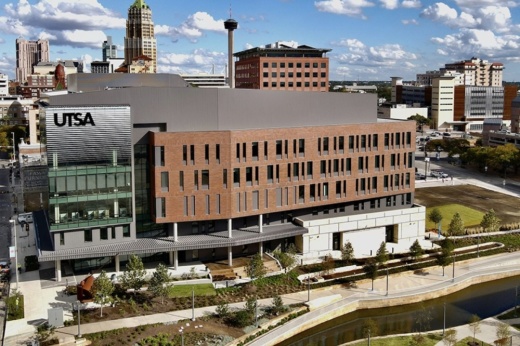The University of Texas at San Antonio on Jan. 9 unveiled San Pedro I, the first phase of a $91.8 million facility that will house UTSA’s School of Data Science and National Security Collaboration Center.
Officials from UTSA, the city of San Antonio, Bexar County and other community partners gathered for a grand opening ceremony for San Pedro I, a 167,000-square-foot structure that sits in downtown along the restored San Pedro Creek and not far from UTSA’s Downtown Campus.
According to a news release, San Pedro I is the first project in UTSA’s phased, 10-year approach to speeding up the expansion of its Downtown Campus and the development of the campus as a producer of data science, data analytics and national security professionals.
San Pedro I was financed with $70 million from The University of Texas System, a $15 million gift from UTSA philanthropist Graham Weston and $5 million in UTSA funds, the release said.
UTSA officials said the new building also helps to position UTSA to better serve San Antonio’s growing population and complement recent downtown-area development.
“We intentionally developed San Pedro I to sit in the heart of downtown San Antonio, where it will attract unique government-university-industry partnerships in the fields of data science, cybersecurity and national security. This is a big day for UTSA, our region and our state,” UTSA President Taylor Eighmy said in a statement.
UTSA officials said the new School of Data Science is the only program of its kind created by a U.S. Hispanic-serving institution.
University officials said this distinction will enable the university to help diversify the nation’s pipeline of data science professionals. According to Forbes magazine and other studies, fewer than 10% of data science professionals are people of color, and 3% are women of color. At UTSA, 56% of master’s students overall are women, and 64% are people of color, the release said.
Kimberly Andrews Espy, UTSA provost and senior vice president for academic affairs, said the university’s new San Pedro I facility will provide new opportunities to align academic offerings across disciplines to meet the evolving needs of San Antonio’s workforce, especially high-tech professionals.
“Through collaborations with local industry partners, our students will gain valuable learning experiences and master the skills to take them from classroom to career,” Espy said in a statement. “The School of Data Science and National Security Collaboration Center will provide unparalleled opportunities that cannot be found anywhere else in the country to San Antonians who dream of pursuing careers in high-tech industries.”
The new school, led by founding Director David Mongeau, will initially offer five best-in-class master’s degree programs in artificial intelligence, computer science with a data concentration, data analytics, statistics and data science, and applied statistics, the release said.
The School of Data Science will also host several boot camps, certificates, seminars and workshops to help emerging and advanced professionals expand their technology skills and grow in their careers, the release said.
Veronica Salazar, UTSA senior vice president for business affairs and chief financial officer, said San Pedro I’s downtown location will enable the university to better connect students with hands-on learning opportunities, particularly high-tech professionals who might be interested in pursuing opportunities at tech startups and established companies located around downtown.
“This state-of-the-art facility serves as a catalyst for advancing educational and career opportunities for UTSA students and also for transforming the core of downtown San Antonio’s tech corridor with new partnerships and prospects,” Salazar said in a statement.
The National Security Collaboration Center, Texas’ largest hub for government, university and industry partners in national security, advances research and innovation in forensics; visualization; cybersecurity; data analytics; post-quantum cryptography; attack and threat modeling and mitigation; machine learning and artificial intelligence; and software, hardware and platform integrity, the release said.
UTSA officials said additional areas of collaboration here include training and exercise evaluation, workforce development, and educational opportunities for students and the broader military community. Retired U.S. Air Force Brig. Gen. Guy Walsh is the NSCC’s executive director.
Several prominent industry leaders have joined the NSCC’s collaborative ecosystem of 89 partners, including Peraton, CACI, CNF Technologies, CPS Energy, Dell Technologies, Leidos, Microsoft Federal and MITRE Corp.
UTSA has also established federal partnership agreements with the Air Force Research Laboratory, U.S. Cyber Command, the Air Education and Training Command, and the Air Combatant Command’s 16th Air Force. The release said several federal laboratories, such as Oak Ridge National Laboratory in Tennessee, have signed partnership agreements with UTSA.
UT System Chancellor James Milliken said the opening of San Pedro I is a big step in UTSA’s emergence as a global leader in education and research.
“This successful collaboration among higher education, government and industry is essential to meeting our state’s growing workforce demands, particularly in fields such as cybersecurity and IT,” Milliken said in a statement.
Weston, an original funder and executive and chair of local tech company Rackspace, praised the opening of San Pedro I.
“The promise and potential of the School of Data Science is that our city’s best and brightest young men and women can grow into the most competitive hires in the fields that will shape the future of our economy, and great companies waging the global battle for tech talent will know that the road to victory goes through San Antonio, Texas,” Weston said in a statement.
The release said UTSA is also planning a $161.2 million Innovation, Entrepreneurship and Careers building, which will be known as San Pedro II, on the opposite side of San Pedro Creek.





